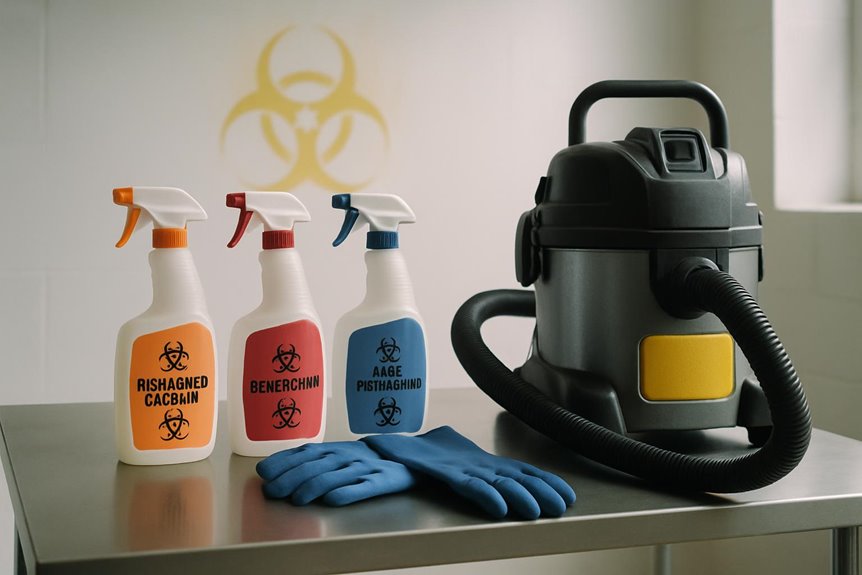Biohazard odors can pose significant challenges, requiring careful attention and effective cleanup strategies. Understanding the nature of these odors is vital for addressing them properly. Personal safety should always come first, making the use of protective equipment essential. Various techniques and materials exist for odor removal, but the effectiveness can vary based on the situation. To uncover the best approaches for specific cases, it’s important to explore the methods available.
Key Takeaways
- Utilize personal protective equipment (PPE) to safeguard against harmful contaminants during the cleanup process.
- Employ odor absorption methods like activated charcoal or baking soda to neutralize unpleasant smells effectively.
- Use chemical neutralization with specialized cleaning agents tailored for biohazard situations to break down odors.
- Consider advanced equipment such as air scrubbers and industrial ozone generators for thorough odor elimination.
- Call in professional services if odors persist or if contamination is extensive to ensure safe and effective remediation.
Understanding Biohazard Odors
Understanding biohazard odors is crucial for effective cleanup and safety management, especially in environments where hazardous materials may be present. These odors can emanate from various biohazard sources, including decaying organic matter, bodily fluids, or chemical spills. Expert biohazard cleanup is essential for odor detection, which plays a critical role in identifying and evaluating the extent of contamination. By recognizing specific smells, individuals can pinpoint the source and determine appropriate actions for remediation. Properly addressing these odors not only guarantees a safer environment but also minimizes potential health risks. Awareness of biohazard odors empowers individuals to act swiftly, maintaining a sense of freedom and safety in their surroundings. Additionally, utilizing proper biohazard cleanup techniques is essential for ensuring thorough remediation. Ultimately, understanding these odors is a fundamental component of successful biohazard management.
Essential Safety Precautions
Safety is paramount when dealing with biohazard cleanup, as exposure to hazardous materials can pose serious health risks.
Individuals engaged in this work must prioritize their well-being and that of others.
Essential safety precautions should always be observed, including:
- Wearing personal protective equipment (PPE) to shield against contaminants
- Properly training in chemical handling to prevent dangerous accidents
- Ensuring adequate ventilation in the work area to reduce inhalation risks
- Keeping first aid supplies readily available for emergencies
Additionally, understanding the role of biohazard cleanup services can provide crucial support in managing these hazardous situations. These services often include specialized training and support to ensure the safety of all involved.
Effective Odor Removal Techniques
Effectively removing biohazard odors requires a systematic approach that combines various techniques and products tailored to the specific situation.
One effective method involves odor absorption, utilizing materials such as activated charcoal or baking soda to trap and neutralize unpleasant smells. These substances can be placed in affected areas to gradually eliminate odors over time.
Additionally, chemical neutralization techniques can be employed, using specialized cleaning agents designed to break down and neutralize odor-causing compounds. It is important to select products specifically formulated for biohazard situations, ensuring safety and efficacy.
Utilizing Professional Equipment
Utilizing professional equipment is essential for achieving thorough biohazard odor cleanup. The use of professional tools and advanced technology not only enhances the efficiency of the cleanup process but also guarantees safety and effectiveness in removing harmful odors.
This specialized equipment empowers individuals to reclaim their environments and restore peace of mind.
- Advanced air scrubbers to filter out toxic particles
- Industrial-strength ozone generators for deep odor elimination
- High-temperature steam cleaners for sanitizing surfaces
- Biohazard waste disposal systems for safe removal
When to Call in Experts
When should one consider bringing in professional help for biohazard odor cleanup? If biohazard signs are present, such as visible contamination or strong, lingering odors, it may be time to seek expert assessment.
Professionals possess the specialized equipment and knowledge necessary to safely and effectively handle hazardous materials and odors. Additionally, if the source of the odor is unknown or if the area affected is extensive, experts can guarantee thorough remediation and compliance with safety regulations.
Homeowners who feel overwhelmed or uncertain about the cleanup process will benefit from the reassurance and expertise that professionals provide.
Ultimately, prioritizing safety and proper handling of biohazard situations is essential for maintaining a healthy living environment.
Frequently Asked Questions
How Long Does Biohazard Odor Removal Typically Take?
The odor removal timeframe varies considerably, influenced by factors such as the extent of contamination, type of materials affected, and methods employed. Professional assessments often determine the most efficient and effective approach for complete odor elimination.
Can I Use Household Products for Biohazard Odor Cleanup?
Using household products for biohazard odor cleanup can be effective; nevertheless, professional-grade odor neutralizers are often recommended for thorough removal. Household cleaners may not adequately eliminate strong odors, potentially leading to lingering issues if misapplied.
What Are Common Sources of Biohazard Odors?
Common sources of biohazard odors include sewage leaks, which release foul smells, and decomposing materials, such as organic waste. Understanding these origins can help individuals address and mitigate unpleasant and potentially harmful odors effectively.
Are There Specific Regulations for Biohazard Cleanup?
Specific regulations for biohazard cleanup exist to guarantee regulatory compliance and uphold cleanup standards. These guidelines help protect public health and safety, allowing individuals to manage biohazardous situations responsibly while maintaining their freedom and wellbeing.
How Can I Prevent Biohazard Odors From Returning?
To prevent biohazard odors from returning, one should employ effective odor neutralization methods alongside preventative measures, such as thorough cleaning and proper ventilation, ensuring a fresh environment free from lingering unpleasant smells and potential health risks.
Conclusion
To summarize, effectively managing biohazard odors requires a careful approach that prioritizes safety and thoroughness. By wearing appropriate protective gear, identifying the odor source, and employing effective removal techniques, individuals can greatly mitigate unpleasant smells. Utilizing specialized equipment can enhance cleanup efforts, but persistent issues may necessitate professional intervention. By following these guidelines, one can guarantee a cleaner, safer environment while effectively addressing biohazard odors.

